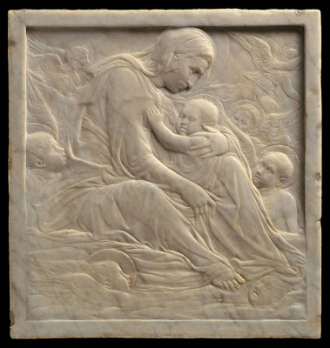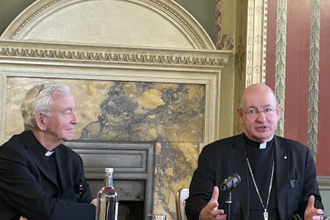Donatello: Sculpting the Renaissance

Madonna of the Clouds, by Donatello. Photo: © 2023. Museum of Fine Arts, Boston
Donatello: Sculpting the Renaissance
at the Victoria and Albert Museum, London to 11 June 2023.
Donatello was the Renaissance's greatest sculptor bringing unsurpassed artistry and emotion to his craft. His influence on sculpture through the centuries was profound, influencing such giants as Michelangelo and Rodin. Donatello's genius is explored in major works, 50 of which have never been seen before in the UK, in an unparalleled display of the master himself, those he collaborated with in various workshops and by artists inspired by him.
Lead Curator Peta Motture said Donatello was "a driving force" of the Italian Renaissance. The exhibition, she said, offered an exceptional opportunity to collaborate with museums in Florence and Berlin to "discover his astonishing talents and impact on the Renaissance and later art." This is the last of three exhibitions in each venue with their own perspective.
Donato di Nicolo di Betto Bardi known as Donatella was born around 1386 in Florence and died there on 13 December 1466. He came from a humble background and his family were mainly labourers in the city's woollen industry.
Donatello initially trained as a goldsmith before joining the workshop of Florence's leading sculptor Lorenzo Ghiberti from 1404-7.
During this time his early sculptures include the striking marble statue of David that stands imposingly at the entrance dominating the exhibition. Portraying the confident youth with the head of Goliath at his feet it is a marvel of artistry. Originally destined for the Cathedral but the Government requisitioned the statue in1416, and it become an emblem of the city. A later statue designed by the older Donatello is also displayed but was executed by one or more of his followers in a pale imitation of the stunning original. A genuine Donatello portrays emotion, it has soul etched into the marble and depth of character. His style influenced the later Renaissance as well as 19th and early 20th century style revivals.
Donatello worked in a range of a materials sculpturally in addition to marble including bronze, terracotta, wood and stucco and examples of these media are displayed.
His vivid portrayals of the Passion undoubtedly drew on the Florentine street theatre enactments of contemporary mystery plays. The epic edici Crucifixion with its gilt bronze relief bears testimony to his goldsmith training.
His powerful, dramatic bronze of the Lamentations over the Dead Christ was probably made for private devotion around 1455-60. It has a contemporary and is full of movement. Mary's aged face is contorted in anguish as she cradles her dead son in her lap. The beloved disciple turns away, hiding his grief and burying his head on his hand. Mary Magdalene is distraught, extending her bare arms towards Christ's slumped body. Another traumatised woman appears to be tearing her hair. Christ's torso in contrast to the rawness of the other figures has a polished smooth skin and his face bears a peaceful countenance.
Noted for his innovative shallow relief carving known as 'relieveo schiacciato' and exemplified in the Museum's own exquisite marble 'Ascension with Christ' giving the keys to St Peter and Boston's 'The Madonna of the Clouds'. This subtle technique requires great skill and Donatello was able to evoke space and depth with lines sketchily carved on the surface.
A dynamic drawing portraying a fragment of "The Massacre of the Innocents" with a triumphant David on the reverse is attributed to Donatello. He considered drawing so essential to the sculptor that he reputedly declared to his pupils one single word - "DRAW!"
A striking bronze reliquary but of San Rossore, also known as St Luxurious, a Sardinian Roman soldier martyred under Diocletian for his faith has a contemplative expression. It is more animated and realistic than traditional reliquary busts.
Donatello's animated delightful bronze spiritelli - youthful cherub like sprites - abound, playing instruments or dancing. They are considered the earliest freestanding spiritelli since classical times.
A notable marbled statue of a youthful John the Baptist carved around 1454-7 is now believed to be designed by Donatello but completed by one of his talented proteges. The Baptist was a significant devotional figure in Florence. The garb of camel hair is particularly realistic and the figure has an air of spiritual intensity redolent of Donatello's work.
A giant crucifix from St Anthony's Basilica Padua vividly portrays Christ at the moment of his death. His ragged loincloth, unusually tied by a rope, seems to flutter in the wind as his spirit leaves his body.
This breathtaking exhibition is highly recommended for all the family with free admittance for children under 12 and reduced rates for 12-26 years.
A lavishly illustrated catalogue explores the artist's life, times and legacy in depth and sells at a special exhibition price of £35.
The exhibition runs until 11 June. Adult Tickets £ 20 Concessions available.
See: www.vam.ac.uk/exhibitions/donatello-sculpting-the-renaissance for details


















